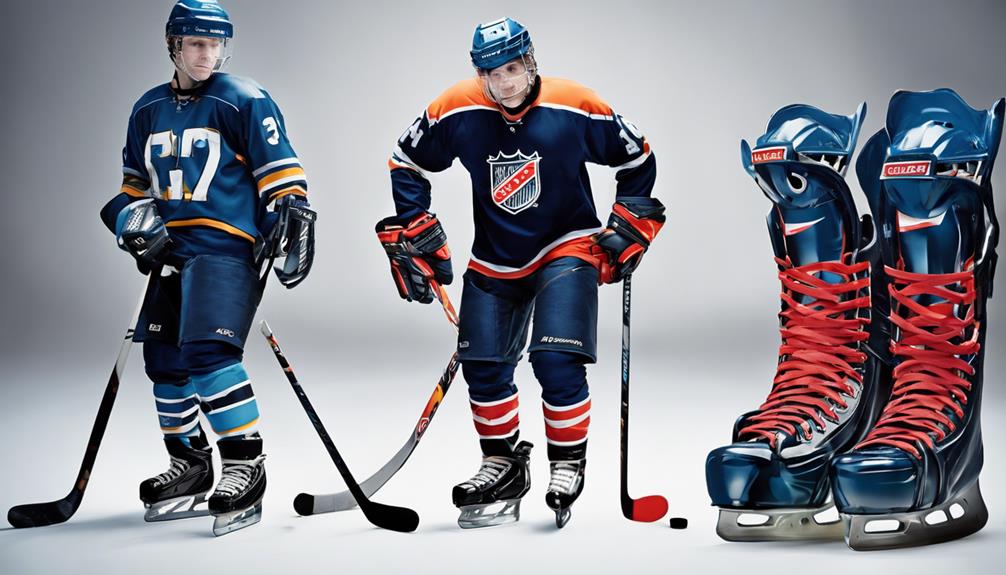The sport of hockey is known for its fast-paced gameplay and physicality, attracting a dedicated following of players and enthusiasts. However, behind the exhilaration of the game lies a financial aspect that is often overlooked.
From the initial investment in equipment to ongoing expenses such as registration fees and travel costs, the total expenditure of participating in this sport can add up quickly. Understanding the various components that contribute to the overall cost of playing hockey is essential for individuals looking to pursue this athletic endeavor.
Average Costs of Hockey Equipment
The average cost of hockey equipment has been steadily increasing over the past decade, reflecting inflation and advancements in technology and materials. Brand preferences play a significant role in these costs, with top-tier brands often commanding higher prices due to their reputation for quality and performance.
However, for those looking to save on expenses, exploring used gear options can be a viable solution. While used equipment may show signs of wear, it can still offer adequate functionality at a fraction of the cost of new items.
Registration Fees for Youth Leagues
Analysis of youth hockey league registration fees reveals a notable trend towards increased financial burdens on participants and their families. As youth hockey gains popularity, registration fees have escalated, making it challenging for some families to afford participation.
However, there are avenues available to alleviate these costs. Fundraising opportunities and financial assistance programs can assist families in covering registration fees. Additionally, sponsorship options provide another way to offset expenses, with businesses often willing to support youth sports programs. Scholarships are also offered by some leagues to ensure that financial limitations do not hinder a child's ability to play hockey.
Travel Expenses for Tournaments
Escalating costs associated with travel expenses for tournaments in youth hockey present a significant financial consideration for participants and their families. Accommodation costs can vary depending on the location and duration of the tournament, ranging from budget-friendly hotel rooms to more expensive options near the venue.
Food expenses also contribute substantially to the overall cost, with families needing to budget for meals during the tournament period. Analyzing these expenses through an economic lens reveals the need for careful financial planning to ensure participation in tournaments remains feasible for all families.
Understanding the breakdown of costs, including accommodation and food, is essential for families to make informed decisions about which tournaments to attend and how to manage their overall hockey-related expenses effectively.
Ice Time Rental Fees per Hour
Amidst the financial considerations of youth hockey, the ice time rental fees per hour play a crucial role in the overall cost structure for families participating in the sport. These fees vary depending on the location and demand for ice time.
Factors such as prime time slots and seasonal ice availability can influence the hourly rates significantly. In addition to the basic rental fees, some facilities may charge extra for services like skate sharpening services, adding to the overall cost.
Families need to carefully budget for these expenses as they contribute substantially to the total cost of playing hockey. Understanding the dynamics of ice time rental fees is essential for families to manage their financial commitments effectively while supporting their young athletes' passion for the sport.
Cost Breakdown for Private Coaching
The financial considerations of youth hockey extend beyond ice time rental fees per hour to encompass a detailed cost breakdown for private coaching services. This sheds light on the specific expenses involved in enhancing players' skills through personalized training. Private coaching for hockey players typically ranges from $50 to $150 per hour, depending on the coach's experience and credentials.
Additional costs may include specialized training equipment, video analysis tools, and access to training facilities. Skill development is a primary focus of private coaching, with coaches using advanced training techniques to improve players' skating, shooting, passing, and overall game strategy.
Investing in private coaching can significantly accelerate a player's progress and performance on the ice, making it a valuable aspect of a player's development in the sport.
Additional Expenses for Team Jerseys
Team jerseys represent a crucial component of a hockey team's identity, with associated costs that contribute to the overall financial investment required for participation in the sport. Custom designs and sizing options are common features that add to the expenses.
Custom-designed jerseys allow teams to showcase their unique branding elements, logos, and colors, fostering a sense of unity and belonging among team members. However, these personalized options often come at a higher cost compared to standard, off-the-shelf jerseys.
Sizing options also play a significant role in the overall expenses, as jerseys need to fit players comfortably to ensure optimal performance on the ice. Therefore, when budgeting for hockey participation, it is essential to consider the additional expenses involved in acquiring team jerseys that align with the team's identity and sizing requirements.
Frequently Asked Questions
Are There Any Financial Aid or Scholarship Opportunities Available for Players Who May Not Be Able to Afford the Costs Associated With Playing Hockey?
Financial aid and scholarships are available for hockey players facing financial barriers. These opportunities aim to make the sport accessible and inclusive. Applicants can explore various programs to support their passion for hockey while alleviating financial burdens.
Are There Any Hidden Costs or Unexpected Expenses That Parents Should Be Aware of When Budgeting for Their Child to Play Hockey?
Parental involvement is akin to a conductor leading an orchestra, requiring financial planning akin to a meticulous score. Hidden costs in hockey can include travel, equipment upgrades, and unexpected tournament fees. Community support and team sponsorships can alleviate some financial burdens.
How Do Costs Vary Depending on the Level of Competition or Skill Level of the Player, Such as Recreational Leagues Versus Competitive Travel Teams?
Costs in hockey vary with the level of competition and player skill. Recreational leagues offer affordable options for skill development and team camaraderie, while competitive travel teams involve higher fees for enhanced training and increased travel expenses.
Are There Any Fundraising Opportunities or Volunteer Opportunities Available to Help Offset Some of the Costs of Playing Hockey?
Fundraising events and volunteer opportunities can greatly reduce the financial burden of participating in hockey. These initiatives not only assist in offsetting costs but also foster a sense of community and teamwork among players and their families.
How Do Equipment and Registration Costs Differ for Adult Leagues Compared to Youth Leagues?
In comparing equipment and registration costs between adult leagues and youth leagues, data indicates that adult leagues often have higher expenses due to the need for larger equipment sizes and advanced skill level requirements, leading to increased registration fees.









